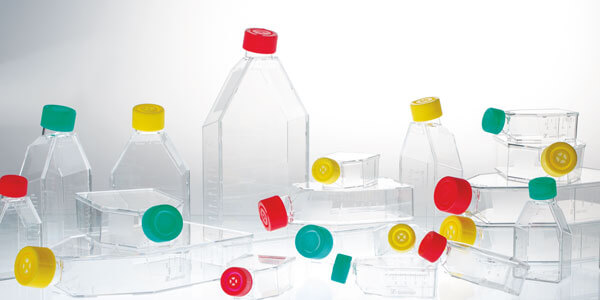Tip of the month: Growth surfaces for cells

The right growth surface makes for happy cells
Selecting a suitable cultivation surface is essential to ensure happy and satisfied cells that demonstrate optimal growth in cell culture. Whether you’re working with suspension cells, adherent cells, or particularly sensitive cells, they all have different requirements with regard to the substrate on which they can or prefer to grow. Below is information about the different Sarstedt growth surfaces to help you choose the right one for your cells.
What growth surfaces are available?
There are three different growth surfaces available for the cultivation of cells. For adherent cells, you can choose between the red colour-coded standard and the yellow colour-coded Cell⁺ surfaces. The treatments applied to these two surfaces enable the adhesion of the cells. Our green colour-coded surface is hydrophobic to minimise cell losses caused by unwanted cell microadhesion during sub-cultivation, and is therefore ideal for the cultivation of suspension cells.
Why are there two different growth surfaces for adherent cells?
Adherent cells often have different requirements when it comes to the growth surface to which they adhere. For example, primary cells, sensitive cell culture lines and cells that are cultivated under serum-reduced/serum-free conditions do not usually adhere to the hydrophilic standard surface (red colour-code) for adherent cells. In these cases, the growth surface must be coated with proteins (e.g. polylysine), resulting in additional time and costs.
Due to its properties, our Cell⁺ surface can make the use of coated culture vessels unnecessary in many cases. Additional polar groups are introduced into the hydrophilic surface by means of a special treatment of the plastic surface. Some sophisticated adherent cell types can adhere and grow directly on the Cell+ surface without an additional protein coating.
Why are TC flasks, dishes and plates colour-coded red, yellow and green?
The colour coding on the cell culture flasks, dishes and plates indicates the surface type of the cell culture vessel:
- red standard surface for adherent cells
- yellow Cell⁺ surface for sophisticated adherent cell types
- green suspension culture surface
The colour code is printed onto each dish and plate, while colour coding of flasks is accomplished by the cap colour. This simple colour coding helps you to quickly find the right surface for your cells, regardless of the cell culture vessel used.
Do the surfaces differ because they have different coatings?
The differing cultivation properties of the growth surfaces result from a physical treatment of the cell culture vessels. There is no coating of the growth surface with proteins, for example.
Is there an overview of which growth surface is suitable for which cells?
In order to help you find the right cultivation surface for your specific cells, you will find an overview as well as literature references in our ‘Growth Surface References’ brochure. This brochure indicates which cells can generally be cultivated on which growth surfaces. Due to the range of factors that can influence cell culture, this information is solely provided for guidance and is not a guarantee. Cell growth must ultimately be tested under the specific conditions in question.
Conclusion:
You can optimise the growth of your cells by choosing the right surface, which is why we offer three different growth surfaces. Our ‘Growth Surface References’ brochure is the first place to look when selecting a surface:

